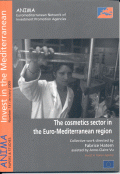
Editeur : Anima/Edisud, notes et études Anima n°13, 55 pages
Auteur : Fabrice Hatem (Sous la direction de), assisté de Anne-Claire Vu
The cosmetics sector in the euroméditerranean region (2005)
The economic development of the MEDA region depends on the exploitation of its sectors of excellence, whether for attracting outside investments or promoting local initiatives. In this context, the « Cosmetics, toiletries and perfumery » activity, in which the region possesses considerable potential assets, and even certain domains of excellence, represents a natural candidate for the implementation of a strategy of a differentiated territorial offer. Yet, to be in a position to do this, it is necessary to undertake an in-depth analysis of the strengths and weaknesses of the local offer in the light of the threats and opportunities of the world market.
ANIMA therefore launched a study with this intention. Its aim, after the initial diagnosis of the status of the territorial offer, was to define proposals for a range of actions to reinforce the cosmetics-perfumery sector in the MEDA region, with the prospect of increased integration with Europe. The study therefore proposes an extended analysis of the whole of the Euro-Mediterranean region. This report presents the main conclusions of this study. After a rapid analysis of the structure of the world market, it details the characteristics of the offer in the Euro-Mediterranean region.
Overall description of the activity
The cosmetics sector covers five families of activity, which are, in decreasing order of importance: toiletry products (deodorants, soaps, etc.), hair care products (shampoos, etc.), skin care products (creams, etc.) perfume and make-up.
In 2002, this market represented around 115 billion euros (ANIMA estimation at wholesale prices according to the Colipa Statistics Working Group). It is an activity which is undergoing rapid growth (in the region of 5 % on average over the last five years), and which touches an increasingly growing number of consumers.
Whereas the markets of the developed countries (Europe, Japan, North America) remain largely dominant (more than 80% of world outlets), a trend may, however, be seen of the gradual saturation of the demand which is in contrast with the dynamism of the emerging countries.
The industrial offer is characterised by the juxtaposition of very large internationalised groups and their highly diversified offer (L’Oréal, Unilever..), and small and medium -sized companies which exploit niche markets. If the latter have until now successfully resisted the pressure from the large groups, certain current trends (increasing power of the distribution industry, increased legislation involving higher development costs) could in time be a threat to them. A clear distinction should, however, be made between the case of cosmetics, an activity where the rules of mass industrial production are fully applied (scale economies, important role of research and development, market power of the large groups, impact of health regulations, etc..) and that of perfumery, which is more propitious for the upkeep of a web of small-sized companies which base their competitiveness on their capacity of innovation and product differentiation.
The MEDA problem
The development of the sector in the MEDA region remains modest for the moment and limited to a few countries. Exports from the area represent hardly 1.5 % of world trade and the external deficit is very high. Only two countries, Turkey and above all Israel, have a significant cosmetics activity.
International investments remain at a low level, including those from Western Europe. Relocation operations from this region while limited have above all turned towards Eastern Europe. Despite relatively active intra-regional trade, there is not as yet any real Euro-Mediterranean movement for industrial integration.
The MEDA countries do, however, have a certain number of assets in the cosmetics domain: an internal market that whilst still modest, is growing; already existing technological and industrial skills in certain countries and with potential in others (Maghreb…); and above all, an age old tradition in the domain of perfumes and cosmetics, based both on the abundance of natural resources and the characteristics of local cultures. This tradition still today results in the existence of a very rich craft activity, which in at least two countries, (Turkey and Israel) has already undergone an industrial transformation and consequently shows good performances in export.
These assets are all the more significant since they are meeting a growing demand for authenticity, craft traditions and exoticism from the consumers in developed countries. The Mediterranean countries, whose image, in the mind of the Western consumer is strongly associated with fragrances, well-being, the cult of the body and physical beauty, have a large role to play in this domain.
However, any exploitation of this potential assumes, other than an improvement in the general business environment, that a series of specific actions are taken in terms of training, upgrading of local industry, image building and the prospecting for foreign investors in those niches where the MEDA countries already have attractive specific advantages. In this respect ANIMA may play a supporting role, in liaison with the promotion agencies concerned.
To download an electronic version of this report : cosmetics
To download a english powerpoint presentation updated in 2008 : cosme2008 (pdf)
to download a powerpoint presentation (in French), click on the following link : presa
Also visit the Anima website : www.animaweb.org